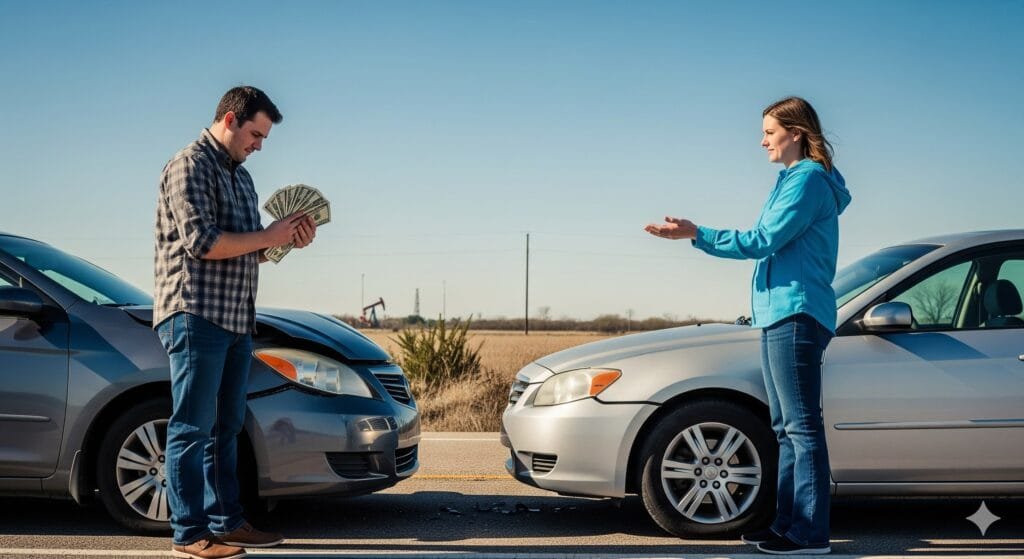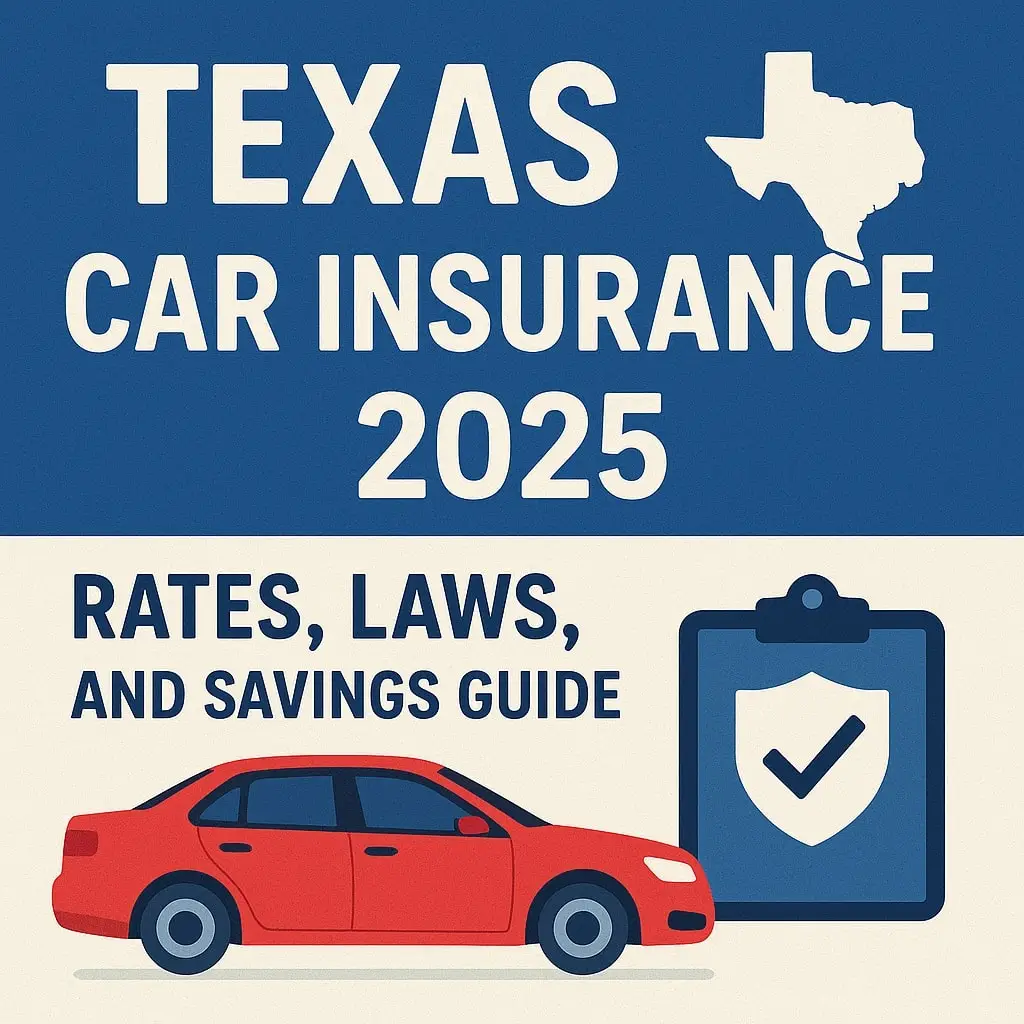Texas is big. From the bustling streets of Houston and Dallas to the scenic Hill Country roads and the long, open highways of West Texas, driving is a core part of life here. With millions of drivers sharing these roads, the risk of an accident is a daily reality. This makes car insurance not just a legal requirement, but a vital financial shield. However, understanding the unique laws, coverage types, and cost factors in Texas can feel as complex as navigating Dallas’s Mixmaster interchange during rush hour.

Did you know that Texas is an “at-fault” state? This means that if you cause an accident, you are financially responsible for the resulting damages and injuries. The state sets minimum insurance requirements, but are they truly enough to protect you from a devastating financial loss? A single serious accident can easily exceed these minimums, leaving your assets, from your savings to your home, at risk. The key to smart protection isn’t just buying insurance; it’s buying the right insurance for your needs without overpaying.
Imagine feeling completely confident that your auto insurance policy is perfectly tailored to your life in Texas. Picture knowing exactly what each coverage does, why you need it, and how to unlock every possible discount to lower your monthly premium. This guide is designed to give you that power. We will break down Texas insurance laws into simple, easy-to-understand terms. We will explore the coverages that offer the best protection against Texas-specific risks, like hailstorms and uninsured drivers. Most importantly, we will reveal the secrets to finding the most affordable car insurance quotes in Texas, empowering you to protect your family and your finances.
This guide will walk you through everything you need to know. By the end, you will be an informed consumer, ready to choose the perfect policy and drive with true peace of mind. Let’s begin.
Is Car Insurance Required in Texas? The Short Answer is Yes.
In the state of Texas, carrying proof of financial responsibility for your vehicle is mandatory. The most common and practical way to meet this requirement is by purchasing an auto liability insurance policy. You must be prepared to show proof of this insurance when you are:
- Registering your vehicle or renewing your registration.
- Getting your annual vehicle inspection.
- Pulled over by a law enforcement officer.
- Involved in a traffic accident.
Penalties for Driving Without Insurance in Texas
Driving without the required minimum insurance in Texas is a serious offence with significant penalties.

- First Offence: Fines can range from $175 to $350.
- Subsequent Offences: Fines can increase to between $350 and $1,000. In addition, you could face the suspension of your driver’s license and the impoundment of your vehicle.
Beyond the legal fines, being an uninsured driver in an accident that you cause means you are personally responsible for all damages. This can lead to lawsuits and financial ruin.
Understanding the Texas “At-Fault” System
Texas operates under a tort, or “at-fault,” insurance system. This is a critical concept to understand because it determines who pays for damages after an accident.
- What “At-Fault” Means: The person who is legally determined to be responsible for causing the accident is also responsible for paying for the resulting damages. This includes the other party’s medical bills, lost wages, and vehicle repairs.
- How It Differs from a “No-Fault” State: In a no-fault state, each driver’s insurance policy pays for their initial medical expenses, regardless of who caused the accident. This is not the case in Texas. The at-fault driver’s liability insurance is the primary source of compensation for the victims.
Because of this system, carrying sufficient liability insurance is not just about following the law; it’s about protecting yourself from being held personally liable for potentially hundreds of thousands of dollars in damages.
Texas Minimum Car Insurance Requirements: The 30/60/25 Rule Explained
Texas law mandates a specific minimum amount of liability coverage, which is often referred to as 30/60/25 coverage. This simple set of numbers represents the foundation of your policy. However, it’s crucial to understand what each number covers and, more importantly, what it doesn’t.
Bodily Injury Liability: $30,000 / $60,000
This coverage pays for injuries to other people when you are at fault in an accident. It does not cover your injuries.
- $30,000 for Bodily Injury Liability per person: This is the maximum amount your insurance will pay for any single person’s injuries in an accident you cause.
- $60,000 for Bodily Injury Liability per accident: This is the total maximum amount your insurance will pay for all injuries combined in a single accident you cause, regardless of how many people are hurt.
Scenario: You cause an accident that injures three people. Person A has $35,000 in medical bills, Person B has $20,000, and Person C has $15,000.
- Your policy will pay the maximum of $30,000 for Person A.
- It will pay the full $20,000 for Person B and the full $15,000 for Person C.
- The total payout is $65,000. Since your per-accident limit is only $60,000, you would be personally responsible for the remaining $5,000 for Person A’s bills.
Property Damage Liability: $25,000
This coverage pays for damages you cause to another person’s property. This most often means their vehicle, but it can also include things like fences, mailboxes, or buildings.
- $25,000 for Property Damage Liability per accident: This is the total maximum amount your insurance will pay for all property damage in a single accident you cause.
Scenario: You accidentally run a red light and hit a brand-new pickup truck. The repair costs for the car are $32,000. Your insurance policy will pay its maximum of $25,000. You will be billed directly for the remaining $7,000.
The Danger of Carrying Only Minimum Coverage
While meeting the 30/60/25 requirement makes you legally compliant, it offers very little financial protection in a moderate to severe accident. Modern medical care is expensive, and the average price of a new car is now well over $40,000. The state minimums have not kept up with these rising costs, making it incredibly easy to exceed your coverage limits and be left with a massive out-of-pocket expense.
Building a Stronger Policy: Essential Coverages Beyond the Minimum
To be truly protected on Texas roads, you should strongly consider adding coverages that go beyond the state-mandated liability insurance. These policies are designed to protect you and your financial well-being.
Personal Injury Protection (PIP)
In Texas, insurance companies are required by law to offer you Personal Injury Protection (PIP). However, you can reject it in writing. It is highly recommended that you carry PIP.
- What it Covers: PIP helps pay for your own and your passengers’ medical bills and lost wages after an accident, regardless of who is at fault.
- Why it’s Important in Texas: As an at-fault state, Texas can make determining who pays for injuries a time-consuming process. PIP provides immediate funds for medical care while the insurance companies sort out liability. The minimum required offer is $2,500, but higher limits are available and recommended.

Uninsured/Underinsured Motorist (UM/UIM) Coverage
Unfortunately, Texas has one of the highest rates of uninsured drivers in the nation. This coverage protects you if you are hit by a driver who has no insurance or not enough insurance to cover your expenses.
- Uninsured Motorist Bodily Injury (UMBI): Pays for your medical bills if you are injured by an at-fault driver with no insurance.
- Underinsured Motorist Bodily Injury (UIMBI): Pays the difference if an at-fault driver has insurance. However, their liability limits are too low to cover all of your medical bills.
- Uninsured/Underinsured Motorist Property Damage (UMPD): Helps pay to repair your car if it’s damaged by an at-fault driver with no or insufficient insurance.
Like PIP, insurers must offer you UM/UIM coverage, and you must reject it in writing if you don’t want it. Given the risks on Texas roads, this is considered essential coverage for most drivers.
Collision Coverage
Collision coverage helps pay to repair or replace your vehicle after it’s damaged in a collision with another object. This could be another car, a pole, a fence, or even a pothole. This coverage applies regardless of who is at fault.
Comprehensive Coverage
Also known as “other than collision” coverage, this helps pay for damages to your car from events that are not a collision. This is particularly important in Texas due to the state’s volatile weather. Examples include:
- Hail damage
- Flooding
- Theft
- Vandalism
- Fire
- Hitting an animal (like a deer)
- Falling objects (like a tree branch)
What Does “Full Coverage” Car Insurance Mean in Texas?
You will often hear the term “full coverage” when shopping for car insurance. However, it’s essential to know that this is not an official type of policy. It is a common shorthand term used to describe a combination of coverages that offers comprehensive protection.
In Texas, “full coverage” typically includes:
- Liability Coverage (Bodily Injury and Property Damage)
- Collision Coverage
- Comprehensive Coverage
While it’s not a legal requirement, if you have a loan on your car or are leasing it, your lender will almost certainly require you to carry full coverage to protect their investment.
Key Factors That Influence Your Texas Car Insurance Quote
Insurance companies use a wide range of data points to calculate your premium. While some are out of your control, understanding these factors can help you identify areas where you might be able to find savings.
- Your Driving Record: This is one of the most significant factors. A history of accidents, speeding tickets, or DUIs will lead to higher rates. A clean record will earn you significant discounts. If you have a serious violation, you may be required to file an SR-22, a certificate of financial responsibility, which will also increase your premium.
- Your ZIP Code: Rates can vary significantly based on where you live. Urban areas like Houston or Dallas typically have higher rates than rural areas due to higher traffic density, theft rates, and accident frequency.
- Your Vehicle: The year, make, and model of your car matter. A new, expensive sports car will cost more to insure than an older, reliable sedan because it is more costly to repair or replace. Vehicles with high safety ratings and anti-theft devices can earn you discounts.
- Your Age and Driving Experience: Younger, less experienced drivers statistically have more accidents, leading to much higher premiums. Rates typically begin to decrease after age 25.
- Annual Mileage: The more you drive, the higher your risk of being in an accident. If you have a short commute or work from home, you may qualify for a low-mileage discount.
- Your Credit History: In Texas, insurers are permitted to use a credit-based insurance score to help determine rates. Statistics show a correlation between credit history and the likelihood of filing a claim.
- Your Chosen Coverages and Deductibles: The more coverage you buy, and the lower you set your deductibles (the amount you pay out-of-pocket before insurance kicks in), the higher your premium will be.
Unlocking Savings: A Guide to Texas Car Insurance Discounts
One of the best ways to lower your car insurance quote in Texas is to take advantage of every available discount. Always ask your insurance agent about these potential savings:
- Bundling (Multi-Policy) Discount: This is often one of the most significant discounts available. By insuring both your car and your home or rental unit with the same company, you can often save a considerable amount on both policies.
- Safe Driver & Violation-Free Discounts: Maintaining a clean driving record for a set number of years (typically 3-5) earns you a lower rate.
- Telematics Programs (Usage-Based Insurance): Programs like Allstate’s Drivewise® or Liberty Mutual’s RightTrack® use a smartphone app or a small device in your car to monitor your driving habits. Safe driving behaviours like smooth braking, safe speeds, and low-mileage driving can earn you substantial discounts.
- Good Student Discount: If you or a driver on your policy is a full-time high school or college student with good grades (usually a “B” average or 3.0 GPA), you can qualify for a discount.
- Defensive Driving Course: Completing an approved defensive driving course in Texas can often lead to a reduction in your premium.
- Vehicle Safety Discounts: Cars equipped with safety features like anti-lock brakes, airbags, and anti-theft systems are cheaper to insure.
- Policy Management Discounts: You can often save a little extra by choosing options like paying your premium in full upfront, signing up for automatic payments (EFT), or going paperless.
How to Get the Best Car Insurance Quotes in Texas: A Step-by-Step Process
Finding the right policy at the best price involves a bit of research, but the effort is well worth it.
- Gather Your Information: Before you start, have the following information handy for all drivers and vehicles you want to insure: driver’s license numbers, vehicle identification numbers (VINs), and your current insurance policy for comparison.
- Determine Your Coverage Needs: Use the information in this guide to decide on the coverage limits and deductibles that make sense for your financial situation. Don’t just default to the state minimums.
- Compare Quotes from Multiple Companies: This is the most critical step. Get car insurance quotes from at least three to five different insurance providers. You can do this online, over the phone, or through an independent agent.
- Ask About Discounts: When getting a quote, be proactive. Ask the agent or check the website for every possible discount you might qualify for.
- Check Company Reputations: The cheapest price isn’t always the best deal. Look up reviews and financial strength ratings (from companies like A.M. Best) to ensure the insurer has a good reputation for customer service and paying claims.
- Review and Finalise Your Policy: Once you’ve chosen a company, carefully review the policy documents before you sign. Make sure all coverages, limits, and discounts are correct.
Navigating Texas Roads: Practical Information for Drivers
- Electronic Proof of Insurance: Texas law allows you to use a digital copy of your insurance ID card on your smartphone or other electronic device as valid proof of insurance. Most major insurers, like Allstate, provide easy access to this through their mobile app.
- Connection to Vehicle Registration: You cannot complete your annual vehicle registration in Texas without showing proof of valid liability insurance. The state’s system often verifies insurance electronically, but it’s always wise to have your card ready.
- Official State Resources: For the most current and detailed information, you can always refer to these official state agencies:
- Texas Department of Insurance (TDI): The primary regulator for insurance in the state.
- Texas Department of Motor Vehicles (DMV): For all vehicle registration and titling needs.
- Texas Department of Public Safety (DPS): For driver’s license information and traffic laws.
Conclusion: Your Road to Confident Coverage
Texas car insurance doesn’t have to be a mystery. By understanding that Texas is an at-fault state, recognising the limitations of the 30/60/25 minimum requirements, and exploring the crucial protections offered by coverages like PIP and Uninsured Motorist, you are already ahead of the curve.
You are now equipped with the knowledge to build a policy that genuinely protects you and your family. Remember to leverage every available discount and, most importantly, to compare car insurance quotes from multiple providers. By taking these steps, you can navigate the Texas roads not just legally, but with the confidence and financial security that comes from having the proper protection on your side. Start comparing quotes today, armed with the knowledge to choose the best policy for your Texas journey.





